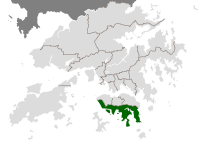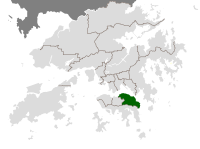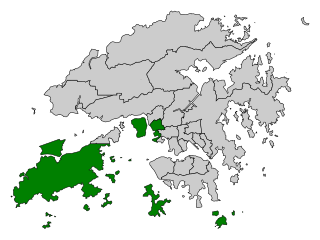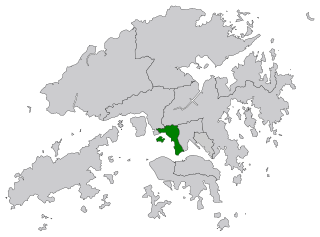
Hong Kong Island was divided into one or more constituencies of the Legislative Council following the first-ever election in 1985.

Hong Kong Island was divided into one or more constituencies of the Legislative Council following the first-ever election in 1985.
In 1985, "East Island" and "West Island" electoral-college constituencies were created. East Island consisted of the Eastern District and the Wan Chai District, while West Island consisted of the Central and Western District and the Southern District. The electoral colleges lasted for two terms until they were replaced by the geographical constituencies in 1991 when the first direct election to the Legislative Council was introduced. [1]
Hong Kong Island was then divided into "Hong Kong Island East" and "Hong Kong Island West" with the same boundaries, each returning two members to the Legislative Council using the two-seat-constituency two-votes system. All four seats were won by the United Democrats of Hong Kong (UDHK) in the pro-democracy electoral landslide. The electoral system was overhauled after one term, replaced by the single-constituency single-vote system in the 1995 Legislative Council election with four new constituencies, namely "Hong Kong Island Central", "Hong Kong Island East", "Hong Kong Island South" and "Hong Kong Island West". All four seats were again won by the pro-democrats, three of them taken by the Democratic Party and one by independent Christine Loh. [2]
Following the handover in 1997, all constituencies on Hong Kong Island were merged into one, the "Hong Kong Island" constituency. It remained in place until 2021 under the change of the electoral system. "Hong Kong Island East" and "Hong Kong Island West", which included the Islands District for the first time, were installed as the new constituencies. [3]
 |  |  |  | ||||
| Years \ Districts | Southern | Central and Western | Wan Chai | Eastern | |||
| Eastern part | Western part | Western part | Central part | Eastern part | |||
| 1985–1991 | Western Island | East Island | |||||
| 1991–1995 | Hong Kong Island West | Hong Kong Island East | |||||
| 1995–1997 | Hong Kong Island South | Hong Kong Island West | Hong Kong Island Central | Hong Kong Island East | Hong Kong Island South | ||
| 1998–2021 | Hong Kong Island | ||||||
| 2021–present | Hong Kong Island West | Hong Kong Island East | |||||

Kowloon East is the eastern part of Kowloon, covering the Wong Tai Sin and Kwun Tong District, with Kowloon City District occasionally included.

Kowloon West is the western part of Kowloon, covering the Yau Tsim Mong and Sham Shui Po District, with Kowloon City District occasionally included.

New Territories East is the eastern part of New Territories, covering North, Tai Po, Sha Tin, and Sai Kung District.

New Territories West (NTW) is the western part of Hong Kong's New Territories, covering Yuen Long, Tuen Mun, Tsuen Wan, Kwai Tsing and the Islands District.

New Territories South-west was a geographical constituencies in the election for the Legislative Council of Hong Kong in 1995, which elects one member of the Legislative Council using the first-past-the-post voting system. The constituency covers southern part of Kwai Tsing District and Islands District in New Territories.

New Territories North was a geographical constituencies in the election for the Legislative Council of Hong Kong in 1995, which elects one member of the Legislative Council using the first-past-the-post voting system. The constituency covers North District and northern part of Yuen Long District in New Territories.

Kowloon Central was a geographical constituencies in the election for the Legislative Council of Hong Kong in 1995, which elects one member of the Legislative Council using the first-past-the-post voting system. The constituency covers Kowloon City District and Wong Tai Sin District in Kowloon.

Hong Kong Island West was a geographical constituency in the election for the Legislative Council of Hong Kong in 1995, which elects one member of the Legislative Council using the first-past-the-post voting system. The constituency covers Central and Western District and parts of Southern District on Hong Kong Island.

Hong Kong Island East was a geographical constituency in the election for the Legislative Council of Hong Kong in 1995, which elects one member of the Legislative Council using the first-past-the-post voting system. The constituency covers part of the Eastern District from east of North Point to west of Chai Wan.

Hong Kong Island Central was a geographical constituencies in the election for the Legislative Council of Hong Kong in 1995, which elects one member of the Legislative Council using the first-past-the-post voting system. The constituency covers Wan Chai District and parts of Eastern District on Hong Kong Island.

Hong Kong Island South was a geographical constituency in the election for the Legislative Council of Hong Kong in 1995, which elects one member of the Legislative Council using the first-past-the-post voting system. The constituency covers Eastern District and Southern District on Hong Kong Island.

Hong Kong Island East was a geographical constituency in the election for the Legislative Council of Hong Kong in 1991, which elects two members of the Legislative Council using the dual-seat constituency dual vote system. The constituency covers Eastern District and Wan Chai District on Hong Kong Island.

Hong Kong Island West was a geographical constituency in the election for the Legislative Council of Hong Kong in 1991, which elects two members of the Legislative Council using the dual-seat constituency dual vote system. The constituency covers Central and Western District and Southern District on Hong Kong Island.

Kowloon East was a geographical constituency in the election for the Legislative Council of Hong Kong in 1991, which elects two members of the Legislative Council using the dual-seat constituency dual vote system. The constituency covers Yau Tsim District, Mong Kok District, and Sham Shui Po District in Kowloon.

Kowloon Central was a geographical constituencies in the election for the Legislative Council of Hong Kong in 1991, which elects two members of the Legislative Council using the dual-seat constituency dual vote system. The constituency covers Kowloon City District and Wong Tai Sin District in Kowloon.

Kowloon West was a geographical constituencies in the election for the Legislative Council of Hong Kong in 1991, which elects two members of the Legislative Council using the dual-seat constituency dual vote system. The constituency covers Yau Tsim District, Mong Kok District, and Sham Shui Po District in Kowloon.

New Territories East was a geographical constituency in the election for the Legislative Council of Hong Kong in 1991, which elects two members of the Legislative Council using the dual-seat constituency dual vote system. The constituency covers Sai Kung District and Sha Tin District in New Territories.

New Territories South was a geographical constituency in the election for the Legislative Council of Hong Kong in 1991, which elects two members of the Legislative Council using the dual-seat constituency dual vote system. The constituency covers Tsuen Wan District, Kwai Tsing District and Islands District.

New Territories East was a geographical constituency in the election for the Legislative Council of Hong Kong in 1991, which elects two members of the Legislative Council using the dual-seat constituency dual vote system. The constituency covers Tuen Mun District and Yuen Long District in New Territories.

New Territories North was a geographical constituency in the election for the Legislative Council of Hong Kong in 1991, which elects two members of the Legislative Council using the dual-seat constituency dual vote system. The constituency covers North District and Tai Po District in New Territories.